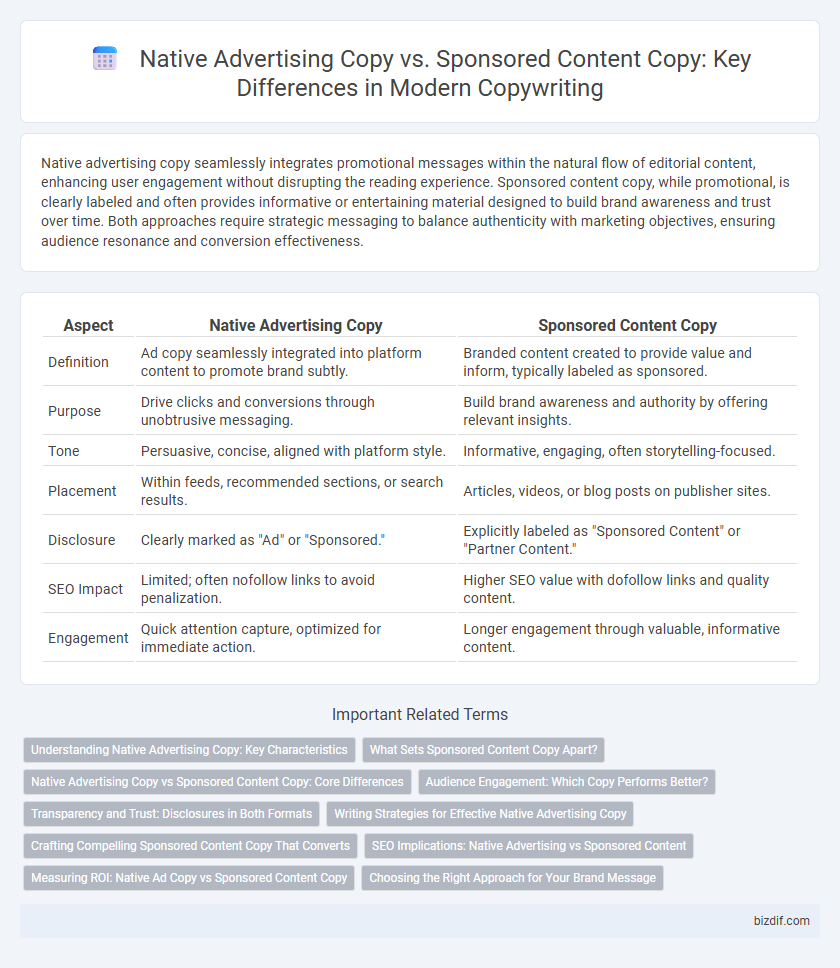Native advertising copy seamlessly integrates promotional messages within the natural flow of editorial content, enhancing user engagement without disrupting the reading experience. Sponsored content copy, while promotional, is clearly labeled and often provides informative or entertaining material designed to build brand awareness and trust over time. Both approaches require strategic messaging to balance authenticity with marketing objectives, ensuring audience resonance and conversion effectiveness.
Table of Comparison
| Aspect | Native Advertising Copy | Sponsored Content Copy |
|---|---|---|
| Definition | Ad copy seamlessly integrated into platform content to promote brand subtly. | Branded content created to provide value and inform, typically labeled as sponsored. |
| Purpose | Drive clicks and conversions through unobtrusive messaging. | Build brand awareness and authority by offering relevant insights. |
| Tone | Persuasive, concise, aligned with platform style. | Informative, engaging, often storytelling-focused. |
| Placement | Within feeds, recommended sections, or search results. | Articles, videos, or blog posts on publisher sites. |
| Disclosure | Clearly marked as "Ad" or "Sponsored." | Explicitly labeled as "Sponsored Content" or "Partner Content." |
| SEO Impact | Limited; often nofollow links to avoid penalization. | Higher SEO value with dofollow links and quality content. |
| Engagement | Quick attention capture, optimized for immediate action. | Longer engagement through valuable, informative content. |
Understanding Native Advertising Copy: Key Characteristics
Native advertising copy seamlessly integrates with the platform's editorial style, ensuring it matches the tone, format, and user experience of the surrounding content. It prioritizes subtle branding and storytelling to engage audiences without disrupting their browsing flow. Key characteristics include relevance to the target audience, non-intrusive presentation, and clear disclosure to maintain transparency and trust.
What Sets Sponsored Content Copy Apart?
Sponsored content copy distinguishes itself by blending promotional messages seamlessly with valuable editorial content, creating a natural and engaging reader experience. Unlike native advertising, which often mimics the platform's overall design and tone, sponsored content provides in-depth storytelling that aligns closely with the audience's interests and the publisher's voice. This approach fosters higher trust and credibility, driving deeper engagement and brand affinity.
Native Advertising Copy vs Sponsored Content Copy: Core Differences
Native advertising copy seamlessly integrates brand messages within the content, matching the platform's style and tone to enhance user engagement without disrupting the user experience. Sponsored content copy, while also branded, is explicitly labeled and designed to provide valuable, often longer-form information that showcases brand expertise or storytelling. The core difference lies in native advertising's subtle, immersive approach versus sponsored content's transparent, informative format.
Audience Engagement: Which Copy Performs Better?
Native advertising copy integrates seamlessly with platform content, boosting audience engagement through relevance and non-disruptive messaging, leading to higher click-through and conversion rates. Sponsored content copy, while informative and brand-aligned, often performs slightly lower in engagement due to its overt promotional tone and separation from editorial content. Data shows native ads generate up to 60% more engagement, making them more effective for capturing audience attention and fostering interaction.
Transparency and Trust: Disclosures in Both Formats
Native advertising copy requires clear disclosures to maintain transparency and build consumer trust, often labeled as "Sponsored" or "Paid Content." Sponsored content copy emphasizes authentic storytelling while incorporating explicit disclaimers to differentiate promotional material from editorial content. Both formats rely on transparent disclosure practices to comply with regulations and foster ethical relationships with audiences.
Writing Strategies for Effective Native Advertising Copy
Effective native advertising copy seamlessly integrates brand messaging with the platform's natural content flow, prioritizing audience relevance and engagement. Utilizing conversational tone, storytelling techniques, and clear calls-to-action enhances authenticity and reader trust, distinguishing it from traditional sponsored content. Emphasizing user-centric benefits while aligning with platform standards drives higher click-through rates and conversion performance in native ad campaigns.
Crafting Compelling Sponsored Content Copy That Converts
Crafting compelling sponsored content copy that converts requires a deep understanding of the target audience's needs and preferences to seamlessly blend promotional messages with valuable information. Effective sponsored content leverages storytelling techniques and authentic brand voice to build trust while subtly driving desired actions such as clicks or purchases. Optimizing headlines, calls-to-action, and integrating relevant keywords enhances search visibility and engagement, maximizing conversion rates in native advertising campaigns.
SEO Implications: Native Advertising vs Sponsored Content
Native advertising copy integrates seamlessly with the platform's editorial content, boosting user engagement and enhancing SEO through higher dwell time and lower bounce rates. Sponsored content copy, often marked as branded or promotional, can impact SEO by potentially limiting backlink value and requiring careful use of nofollow or sponsored tags to comply with search engine guidelines. Understanding the SEO implications of both formats is essential for maximizing organic search visibility and maintaining compliance with Google's algorithm updates.
Measuring ROI: Native Ad Copy vs Sponsored Content Copy
Measuring ROI in native advertising copy often yields higher engagement rates and better brand recall due to its seamless integration within the user experience. Sponsored content copy typically drives increased website traffic and lead generation by offering valuable, informative content that aligns with audience interests. Analyzing metrics like click-through rates, conversion rates, and time spent on content allows marketers to accurately assess the effectiveness and return on investment of each copy format.
Choosing the Right Approach for Your Brand Message
Native advertising copy seamlessly integrates promotional content within the user experience, aligning tone and style with the platform to enhance engagement and trust. Sponsored content copy explicitly discloses brand association while providing informative or entertaining material, prioritizing transparency and credibility with the audience. Selecting the right approach hinges on your brand's messaging goals, target audience preferences, and the desired balance between subtlety and directness in communication.
Native Advertising Copy vs Sponsored Content Copy Infographic

 bizdif.com
bizdif.com